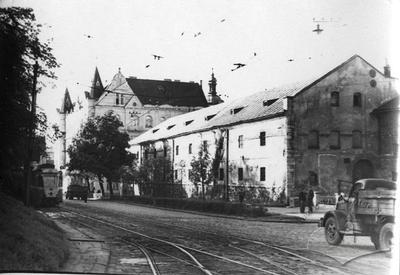Vul. Pidvalna, 3/ vul. Valova, 31 – office building (former residential)
Architecture
The four-storied building forms the butt end of the block located between Valova, Pidvalna, and Brativ Rohatyntsiv streets. It is visually perceived as a single two-part house though formally consists of two houses. Its southern half, whose address is Valova street 31, is a reconstructed three-storied townhouse built in the first half of the 19th c. Its northern half, whose address is Pidvalna street 3, was built in 1910-1912. The two parts are somewhat different as regards their layout; they have separate entrances and are separated from each other by a firewall; their façades are slightly different too.
The house has four floors and cellars. Its walls are of brick, reinforced concrete and metal structures were used in the bridgings; the roof structure is wooden. The walls are plastered, metal is used in the façade decoration (balcony railings, window jardinières). The roof is covered with slate.
The building has a complex configuration in plan, with a courtyard. Its ground floor was occupied by a two-room apartment (from the side of Valova street, to the left of the entrance) and thirteen shops. Two of them overlooked Valova street, five could be entered from Pidvalna street and six from Brativ Rohatyntsiv street. Each had its own separate entrance from the street and a warehouse. The warehouses were chiefly located on the ground floor behind the sales area; however, a few were situated in the basement and could be accessed via winding stairs. These cellars in the northern half of the house had light shafts which were glazed at the sidewalk level.
Two more doors, now functioning as the main entrances, led to the residential premises. One was located on Valova street while the second was from Pidvalna street; initially, it was placed asymmetrically, the second one on the right, and now it has been shifted to the center of the façade. Floors 2-4 served as residential ones. There were large five-room apartments with spacious living rooms there. Each of them contained kitchens, bathrooms, toilets, pantries, and small rooms for servants.
On the outside, the house features some Historicist elements, which combine Neo-Renaissance, Neo-Gothic, and Secession stylistic motifs. The richest decoration can be seen on the façade overlooking Pidvalna street. Its composition is close to symmetric. The house’s corners are accentuated by bay windows topped with spires and steep attics on the lateral façades. The façades are rusticated and divided horizontally by cornices separating the ground floor and the fourth floor. The second and third floors are divided by pilasters and three-quarter columns with Ionic capitals. The fourth floor is divided by lesenes and topped with a Neo-Renaissance attic having volutes. The ground floor and third floor windows are rectangular, the second and fourth floor windows are arched and semicircular. They are grouped in biforia on the second and fourth floors and in triforia on the extreme axes and on the third floor.
The lateral façades are asymmetrical. The south one (overlooking Valova street) has retained the rhythm and rectangular windows of the old townhouse, and this is what distinguishes it from the rest of the house. The ground floor windows on all façades are the result of the reconstructions the building underwent in the interwar period when the premises were adapted for the needs of the publishing house, which was located there; they were doors before.
The building has survived until today with some changes in the layout. In particular, the entrance on the east façade was shifted, a Neo-Gothic wooden door was produced for it. In general, on the outside the house has been preserved in good condition having retained most of its decorative elements (window woodwork, slate roofing, plastered textures of the façades, etc.).
Personalities
Henryk Hescheles (1886–1942) — an editor, literary and theater critic, an interpreter, a public figure. During 1920-1939 he was the main editor of Chwila magazine. He resided at vul. Pidvalna, 3 and was the administrator of this building
Ludmilla z Leszczyńskich Dornbachowa — co-owner of the neighboring building at vul. Sobieskiego, 32 (today vul. Brativ Rohatytsiv, 32) in the 1930s, wife of Tadeusz Dornbach
Tadeusz Dornbach, †1935/1936 — a lawyer, co-owner of the neighboring building at vul. Sobieskiego, 32 (today vul. Brativ Rohatytsiv, 32)
Fryderyk Kapralik — owner of previous buildings on the site at least in 1881-1889
Józef Leliwa Karpiński — an actor, a resident of an apartment in he neighboring building at vul. Sobieskiego, 32 (today vul. Brativ Rohatytsiv, 32)
Maksymilian Kogut (1883–1942/1943) — an engineer, co-author of a project of reconstruction of printing premises in the building
Józef Joachim Tisch — an engineer, co-author of a project of reconstruction of printing premises in the building
Salomea Ulam — a co-owner of the building on vul. Valova, 31 in 1935
Maurycy Sprecher — a co-owner and commisioner of the building, an enterpreneur who owned a factory. He resided at vul. Bohomoltsia, 3
Max Sprecher, Dr — a co-owner and commisioner of the building
Sources
1. State Archive of Lviv Oblast (DALO), 2/2/2868
2. Barbara Łętocha, "Chwila" Gazeta Żydów Lwowskich, (Warszawa, Instytut Lwowski, 1996)
3. Ілько Лемко, Володимир Михалик, Георгій Бегляров, 1243 вулиці Львова (1939–2009), (Львів: Апріорі, 2009, 526).
Media Archive Materials
Related Pictures













